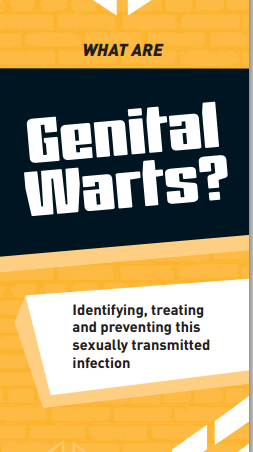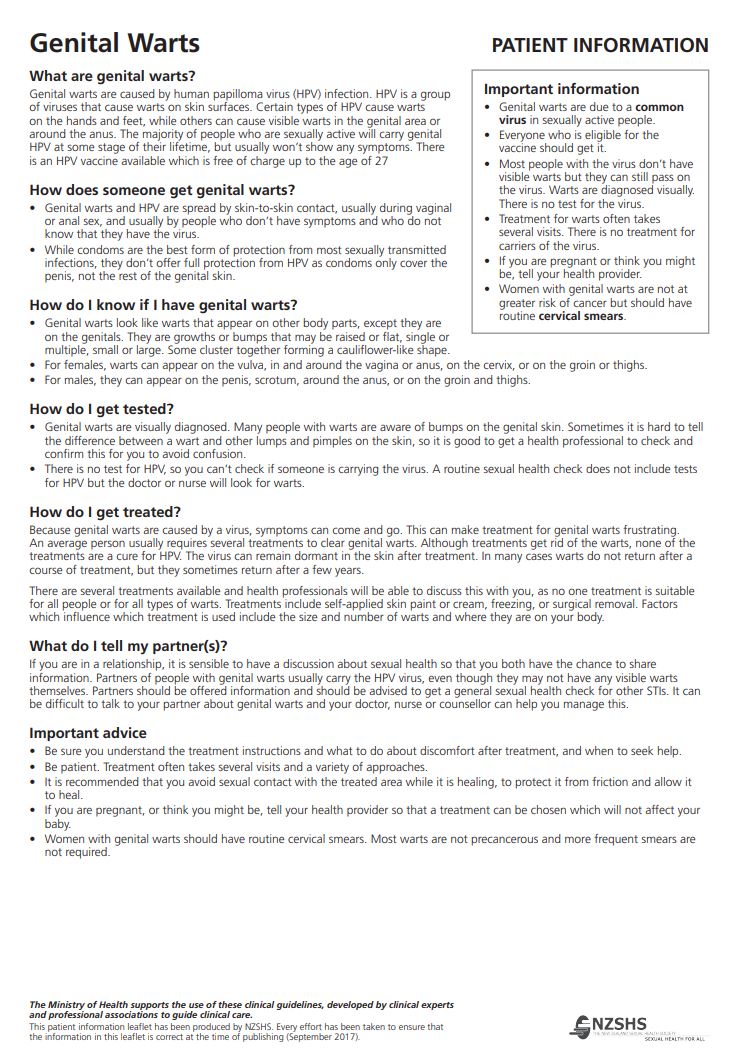Treatment is only recommended if the symptoms of genital warts are disturbing, eg, they cause pain, inflammation, bleeding or embarrassment. Your healthcare provider may recommend no treatment if your warts don’t cause any symptoms or problems. Warts can go away without treatment in about 30% of people over a 6-month period.
Treatment for genital warts depends on several factors such as the size and number of warts, the location, whether you are pregnant and your sex. Your healthcare provider will discuss the treatment options with you depending on your condition. A combination of different treatments may be recommended.
The 2 main types of treatment for genital warts are applying a cream or freezing with liquid nitrogen. Talk to your doctor about which option is best for you. The decision will be based on factors such as the size and number of warts, the location, whether you are pregnant and your gender.
Cream treatment
Podophyllotoxin solution (Condyline®)
- Podophyllotoxin solution (Condyline®) is recommended for males only.
- This solution is applied directly on to the wart 2 times a day for 3 days in a row, followed by 4 days’ rest. This is one course of treatment.
- It's best to apply the solution only to the warts (avoiding the surrounding normal skin).
- If the warts are not completely better, the course of treatment for 3 days and rest for 4 days is repeated every week for up to 5 weeks.
- Most people need 4 or 5 courses of treatment.
- Podophyllotoxin solution stops the wart growing and causes it to shrivel.
- Avoid sexual intercourse during treatment.
- You may experience some irritation when you apply the liquid – this is the solution working to kill the wart tissue.
- Read more about podophyllotoxin solution.
Imiquimod cream (Aldara®)
- The cream is rubbed into the wart and then washed off after 6–10 hours, eg, you can apply the cream before going to bed and wash it off in the morning.
- This should be done 3 times a week.
- It can often take several weeks of treatment before you notice an improvement.
- This treatment works by helping stimulate your immune system into attacking the warts.
- You may experience some mild irritation when you apply the cream.
- Not for use in pregnancy.
- Read more about imiquimod cream.
Freezing with liquid nitrogen (cryotherapy)
- Freezing the wart using liquid nitrogen is known as cryotherapy.
- It is usually recommended to treat multiple small warts, particularly those that develop on the shaft of your penis or on or near your vulva.
- During cryotherapy treatment, you will experience a mild to moderate burning sensation.
- Once the treatment has finished you may develop skin irritation, blistering and pain at the site of the wart.
- Your skin will take between 1 and 3 weeks to heal.
- Avoid having sex until the area of skin around the wart has fully healed.
There are other surgical procedures that can be done including:
- Laser treatment using an intense beam of light. This can be expensive, is not available in all regions of Aotearoa New Zealand and can result in scarring and pain.
- Direct removal of warts using scissors or a scalpel done under local or general anaesthetic. There may be some pain afterwards.
- Electrocautery to burn off the warts. There may be pain and swelling afterwards.
- Using a treatment solution called trichloroacetic acid to burn off warts chemically. There may be mild skin irritation, sores or pain afterwards.
Talk to your healthcare provider to find out which treatment is the best for you.
How long does genital wart treatment take?
For most people, it can take several months to remove the warts, so it's important to stay with the treatment. Although treatment can result in the disappearance of genital warts, the viral infection is not totally gone. The virus can remain dormant (inactive) in your skin after treatment.
In many cases, warts don’t come back after a course of treatment but sometimes they return after a few years.








